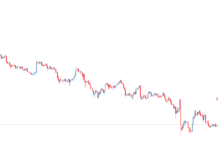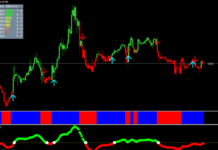Technical indicators have a long history, with some of them introduced even before the era of computers. For example, the well-known Ichimoku indicator was developed in Japan in the 30s! Back then, there was no such thing as automated calculations, and traders had no other choice but to use the indicator manually.
Technical indicators are smart algorithms that allow traders to predict price behavior based on historical quotes over a given period of time.
Each technical indicator uses a certain calculation formula. Formula can vary depending on the type and purpose of an indicator. For example, Indicator A calculates the average price over a given period, Indicator B determines closing and opening prices, and so on.
As computers grew more available, traders could use technical indicators in an automated mode. This made a trader’s life much easier.
Needless to say, technical indicators are the absolute favorite tool of many traders. The thing that attracts traders most is that they don’t need to do the math. An indicator does all the routine work and issues a ready-to-use trading signal (buy/sell).
Table of Contents
How technical indicators work
According to the Dow theory, any factor that affects a price is already taken into consideration by the market. In that sense, a technical indicator shows price fluctuations that already incorporate all major market information. For many traders, this axiom is reason enough not to use fundamental analysis and only focus on what’s going on in the chart. Technical indicators can predict trend reversals, supply and demand, and other important parameters. Furthermore, technical indicators help traders determine market volatility and trading volume.

Classification
All technical indicators fall into two main groups:
- Trend indicators.
- Oscillators.
Plus, there is another classification that divides technical indicators into two types:
- Volume indicators.
- Channel indicators.
Trend indicators
Trend indicators represent algorithms that monitor a trend. Most trend indicators use a moving average that comes in a bunch of variations. By using one or several moving averages, you can identify the beginning and end of a trend with a high degree of accuracy.
The importance of trend indicators is hard to overestimate. For a trader, it’s an easy way to understand what is happening in the market and where a price is going. If moving averages are going up, there is an uptrend. If moving averages are going down, there is a downtrend. Along with the direction of a trend, trend indicators identify overbought and oversold areas and other factors that help predict a trend reversal.
Relying on a trend indicator alone is a quite risky approach. We recommend using trend indicators in conjunction with other tools, i.e. as a part of a trading strategy. This is when trending indicators can serve you best.
List of trend indicators
- Linear Regression Indicator, LRI
- Price Channel, PC
- Standard Deviation, SD
- Moving Average, MA
- Alligator
- Bollinger Bands
- Accumulation Swing Index, ASI
- Envelopes
- Fractals
- Andrew’s Pitchfork
- Donchian Channels
- Average Directional Index, ADX
- Parabolic SAR
- ZigZag
- Ichimoku Kinko Hyo
Oscillators
Oscillators, also known as countertrend indicators, make up the second group of technical indicators. Oscillators are used in ranging markets when there is no strong trend. Countertrend indicators are plotted in a separate window as curves fluctuating within a certain range.
Stochastic and Relative Strength Index (RSI) are the two most popular oscillators. Both of these tools are extremely good at predicting trend reversals in a ranging market.
Another big advantage is that oscillators issue several types of trading signals. They can recognize overbought/oversold zones, identify divergence between price and indicator values, predict the continuation of a short-term trend within a trading range, etc.
List of oscillators
- Gator Oscillator
- Moving Average of Oscillator, OsMA
- Stochastic Oscillator
- Relative Vigor Index, RVI
- Relative Strength Index, RSI
- Price Rate of Change, ROC
- Mass Index, MI
- Commodity Channel Index, CCI
- Directional Movement Index, DMI
- Accumulation/Distribution, A/D
- Moving Average Convergence/Divergence (MACD)
- Momentum
- On Balance Volume, OBV
- Force Index, FRC
- Elder Rays
- Ultimate Oscillator
- Detrended Price Oscillator, DPO
- DeMarker, DeM
- Awesome Oscillator
- Chaikin’s Volatility, CHV
- Chaikin Oscillator, CHO
- Average True Range, ATR
- Triple Exponential Average (TRIX)
- Volume-Weighted Average Price, VWAP
- Bears Power and Bulls Power
Keep in mind that oscillators are useless in a trending market. With that said, you need to use additional tools to be able to identify when a price leaves a trading range and starts trending. This is why trading strategies combine a variety of indicators that perform different functions.
The indicators developed by Bill Williams make up a group of their own. As you probably know, Bill Williams is an iconic trader and market analyst, who revolutionized technical analysis and invented a bunch of popular indicators.
Bill Williams indicators
- Accumulation/Deceleration, AD
- Alligator
- Awesome Oscillator
- Fractals
- Gator Oscillator
- Market Facilitation Index, MFI
How to use technical indicators
Technical indicators are mostly used by short-term traders interested in almost instant results. At the same time, long-term investors prefer fundamental analysis.
Before using a technical indicator in real-money trading, take ample time to understand the mechanism behind it. This way, based on the current market situation, you’ll be able to determine whether you should act on a signal issued by a technical indicator and ignore it.
Most technical indicators can be easily customized to fit your trading preferences, such as periods, intervals, etc. By changing the settings, you can increase or decrease the sensitivity of an indicator. There is no such thing as one-size-fits-all settings. Optimal settings vary depending on the current market situation. By the way, you can successfully use the default settings. If, however, you want to change them, you must understand what you want to achieve by doing this.
Technical indicators are incorporated in both manual strategies and automated advisors. Nowadays, you can hardly make a winning trade without understanding the basics of technical analysis.
While technical indicators are multi-purpose tools that can do lots of useful things, it’s important to pair them with other trading techniques for more accurate signals. This is the only way to generate consistently good trading results.





